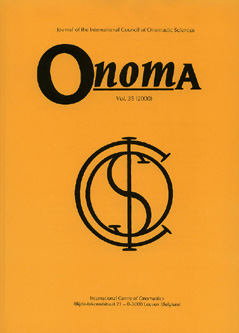 previous article in this issue previous article in this issue | next article in this issue  |

Preview first page |
Document Details : Title: Place-Names as Constructions Author(s): LEINO, Antti Journal: Onoma Volume: 41 Date: 2006 Pages: 215-235 DOI: 10.2143/ONO.41.0.2119617 Abstract : Cognitive linguistics claims as one of its basic tenets that there is no fundamental distinction between grammar and lexicon. Another common claim is that syntax and semantics are not autonomous but rather intertwined with each other. Despite the fact that both claims appear to fit names even more closely than language in general, onomastics has received relatively little attention from practitioners of cognitive linguistics. My goal in this article is thus twofold. On one hand, I intend to show that a cognitive approach can be used successfully as a tool in the analysis of place names. To illustrate this, the article relies on a computerized corpus of 58,000 Finnish lake names. A preliminary study revealed a complex network of relationships between the names, and these have been subsequently analysed in terms of Radical Construction Grammar. On the other hand, and based on experiences gained during the analysis, I propose certain adjustments to the theoretical framework. An onomastic study shows, much more clearly than that of more traditional linguistic phenomena, that the line between productive and non-productive is not a sharp one. This gives new insights on prototypicality and how it can be incorporated into a construction-based theory. La linguistique cognitive revendique comme l’un de ses principes de base qu’il n’y a pas de distinction fondamentale entre la grammaire et le lexique. Un autre argument commun est que la sémantique et la syntaxe ne sont pas autonomes mais étroitement liés l’une à l’autre. Bien que les deux revendications paraissent assembler les noms propres encore plus étroitement que le langage en général, l’onomastique a reçu relativement peu d’attention des praticiens de la linguistique cognitive. Mon but dans cet article est donc double. D’une part, je souhaite montrer que l’approche cognitive peut être utilisée avec succès comme un outil dans l’analyse des noms de lieux. Pour l’illustrer, l’article s’appuie sur un corpus informatisé de 58000 noms de lacs finlandais. Une étude préliminaire a révélé un réseau complexe de relations entre les noms qui ont ensuite été analysés en termes de grammaire de construction radicale. D’autre part, et sur l’expérience acquise lors de l’analyse, je propose certains ajustements au cadre théorique. Une étude onomastique montre, beaucoup plus clairement que celle de davantage de phénomènes linguistiques traditionnels, que la ligne entre productifs et non productifs n’est pas très nette. Ce qui engendre de nouvelles perspectives sur la prototypicalité et son intégration dans une théorie fondée sur la construction. Die kognitive Linguistik nimmt als einen ihrer Grundsätze an, dass es zwischen Grammatik und Lexikon keinen fundamentalen Unterschied gibt. Ein anderer verbreiteter Grundsatz ist, dass Syntax und Semantik nicht autonom nebeneinander existieren, sondern vielmehr miteinander verflochten sind. Obwohl beide Grundsätze auf Namen noch mehr zutreffen zu scheinen als auf Sprache im Allgemeinen, hat die Onomastik von Praktikern der kognitiven Linguistik relativ wenig Aufmerksamkeit erfahren. In diesem Artikel verfolge ich ein zweifaches Ziel. Einerseits möchte ich zeigen, dass eine kognitiver Ansatz für die Analyse von Ortsnamen erfolgreich genutzt werden kann. Um das zu verdeutlichen, stützt sich der Artikel auf ein computerbasiertes Korpus von 58.000 finnischen Seenamen. Vorausgehende Studien ließen ein komplexes Netzwerk von Beziehungen zwischen den Namen erkennen, welches anschließend im Sinne der Radical Construction Grammar analysiert wurde. Andererseits schlage ich, mich auf während der Analyse durchgeführte Experimente stützend, bestimmte Korrekturen des theoretischen Rahmens vor. Eine onomastische Studie zeigt sehr viel klarer als Studien traditionellerer linguistischer Phänomene, dass die Trennlinie zwischen produktiv und nichtproduktiv nicht sehr stark ausgeprägt ist. Hierdurch lassen sich neue Einsichten bezüglich Prototypikalität und darüber, wie diese in einen konstruktionsbasierte Theorie eingefügt werden können, gewinnen. |
|


